YAMAHA YZ125LC 2013 Owner's Manual
Manufacturer: YAMAHA, Model Year: 2013, Model line: YZ125LC, Model: YAMAHA YZ125LC 2013Pages: 168, PDF Size: 8.19 MB
Page 21 of 168
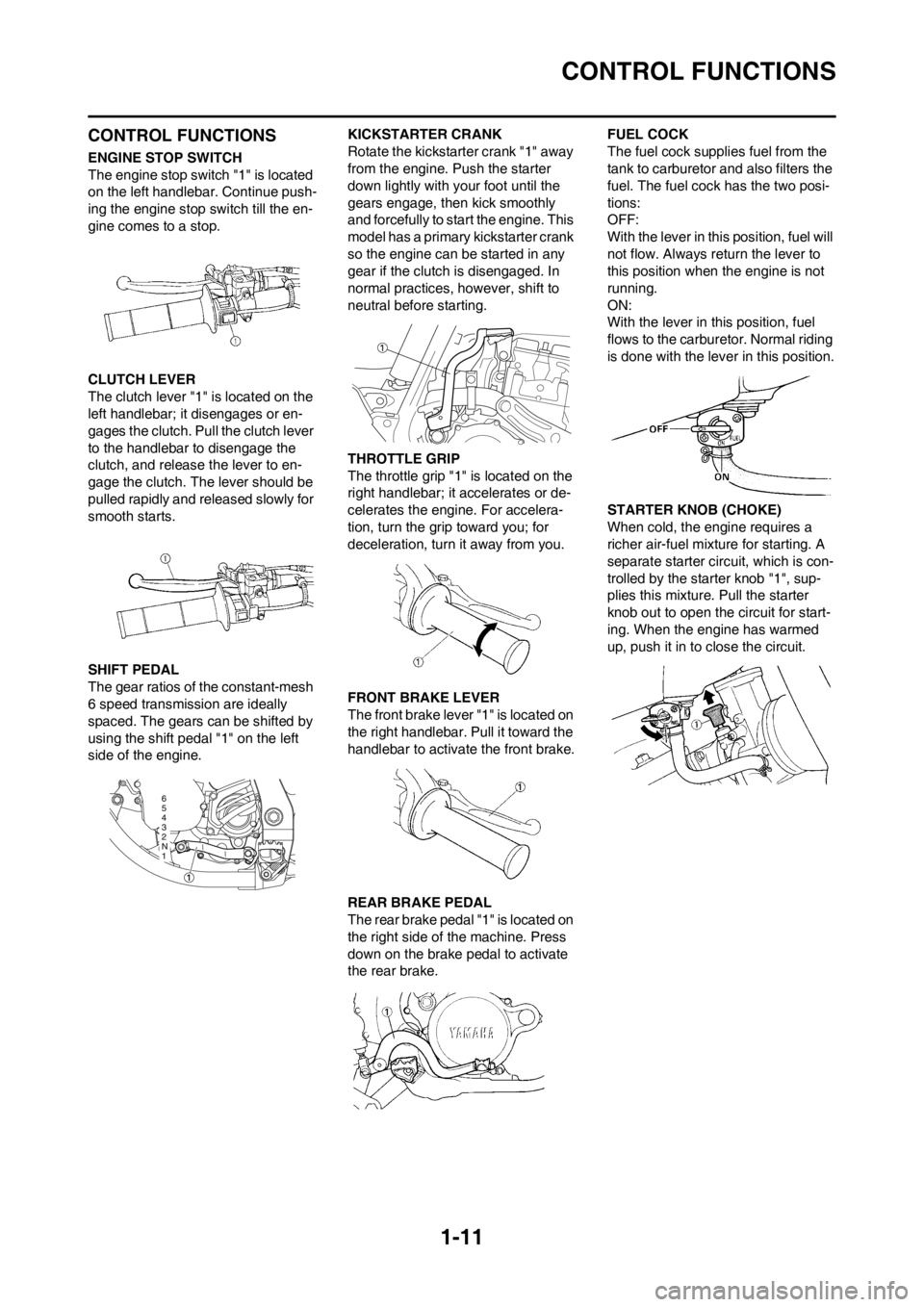
1-11
CONTROL FUNCTIONS
CONTROL FUNCTIONS
ENGINE STOP SWITCH
The engine stop switch "1" is located
on the left handlebar. Continue push-
ing the engine stop switch till the en-
gine comes to a stop.
CLUTCH LEVER
The clutch lever "1" is located on the
left handlebar; it disengages or en-
gages the clutch. Pull the clutch lever
to the handlebar to disengage the
clutch, and release the lever to en-
gage the clutch. The lever should be
pulled rapidly and released slowly for
smooth starts.
SHIFT PEDAL
The gear ratios of the constant-mesh
6 speed transmission are ideally
spaced. The gears can be shifted by
using the shift pedal "1" on the left
side of the engine.KICKSTARTER CRANK
Rotate the kickstarter crank "1" away
from the engine. Push the starter
down lightly with your foot until the
gears engage, then kick smoothly
and forcefully to start the engine. This
model has a primary kickstarter crank
so the engine can be started in any
gear if the clutch is disengaged. In
normal practices, however, shift to
neutral before starting.
THROTTLE GRIP
The throttle grip "1" is located on the
right handlebar; it accelerates or de-
celerates the engine. For accelera-
tion, turn the grip toward you; for
deceleration, turn it away from you.
FRONT BRAKE LEVER
The front brake lever "1" is located on
the right handlebar. Pull it toward the
handlebar to activate the front brake.
REAR BRAKE PEDAL
The rear brake pedal "1" is located on
the right side of the machine. Press
down on the brake pedal to activate
the rear brake.FUEL COCK
The fuel cock supplies fuel from the
tank to carburetor and also filters the
fuel. The fuel cock has the two posi-
tions:
OFF:
With the lever in this position, fuel will
not flow. Always return the lever to
this position when the engine is not
running.
ON:
With the lever in this position, fuel
flows to the carburetor. Normal riding
is done with the lever in this position.
STARTER KNOB (CHOKE)
When cold, the engine requires a
richer air-fuel mixture for starting. A
separate starter circuit, which is con-
trolled by the starter knob "1", sup-
plies this mixture. Pull the starter
knob out to open the circuit for start-
ing. When the engine has warmed
up, push it in to close the circuit.
Page 22 of 168
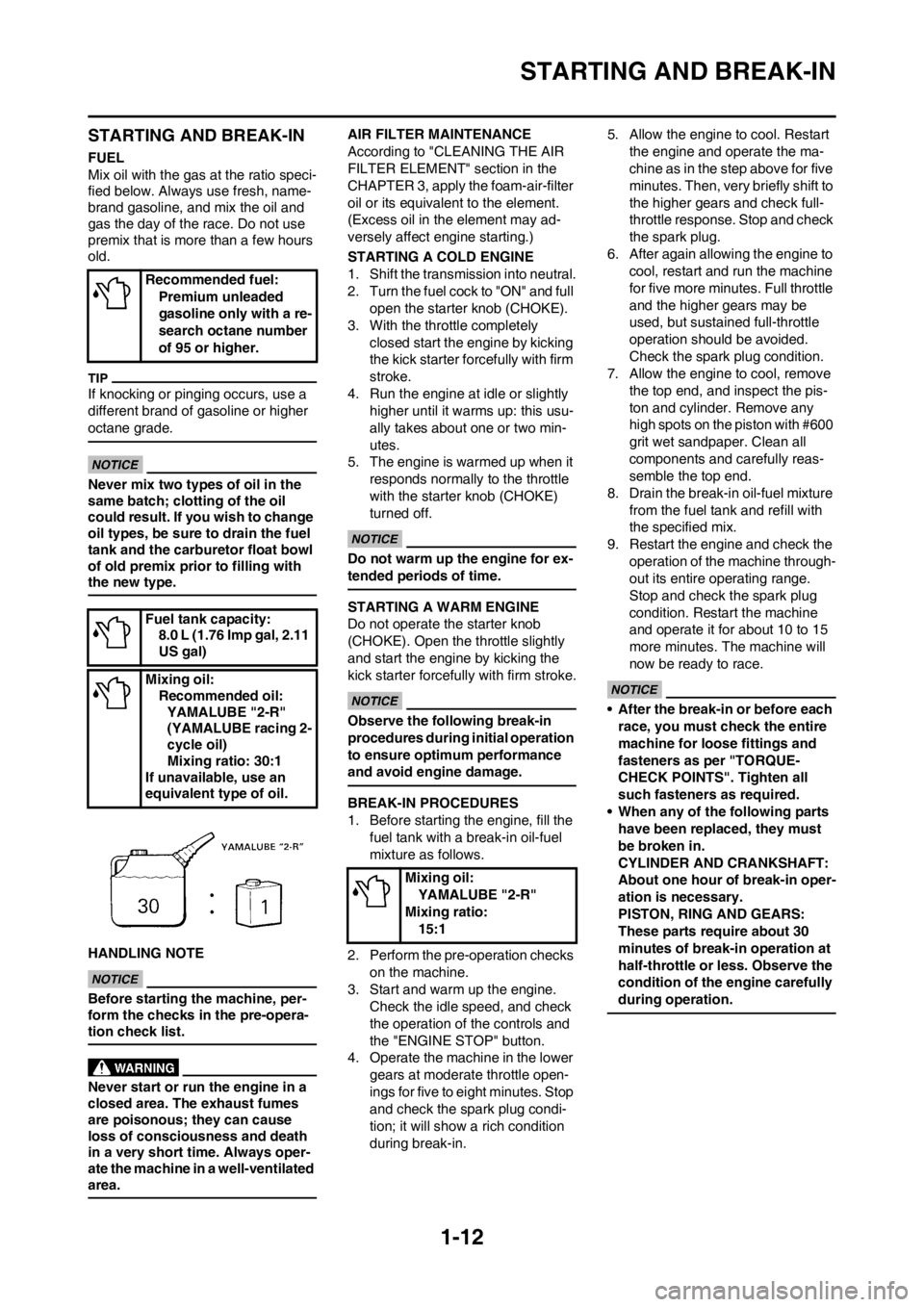
1-12
STARTING AND BREAK-IN
STARTING AND BREAK-IN
FUEL
Mix oil with the gas at the ratio speci-
fied below. Always use fresh, name-
brand gasoline, and mix the oil and
gas the day of the race. Do not use
premix that is more than a few hours
old.
If knocking or pinging occurs, use a
different brand of gasoline or higher
octane grade.
Never mix two types of oil in the
same batch; clotting of the oil
could result. If you wish to change
oil types, be sure to drain the fuel
tank and the carburetor float bowl
of old premix prior to filling with
the new type.
HANDLING NOTE
Before starting the machine, per-
form the checks in the pre-opera-
tion check list.
Never start or run the engine in a
closed area. The exhaust fumes
are poisonous; they can cause
loss of consciousness and death
in a very short time. Always oper-
ate the machine in a well-ventilated
area.
AIR FILTER MAINTENANCE
According to "CLEANING THE AIR
FILTER ELEMENT" section in the
CHAPTER 3, apply the foam-air-filter
oil or its equivalent to the element.
(Excess oil in the element may ad-
versely affect engine starting.)
STARTING A COLD ENGINE
1. Shift the transmission into neutral.
2. Turn the fuel cock to "ON" and full
open the starter knob (CHOKE).
3. With the throttle completely
closed start the engine by kicking
the kick starter forcefully with firm
stroke.
4. Run the engine at idle or slightly
higher until it warms up: this usu-
ally takes about one or two min-
utes.
5. The engine is warmed up when it
responds normally to the throttle
with the starter knob (CHOKE)
turned off.
Do not warm up the engine for ex-
tended periods of time.
STARTING A WARM ENGINE
Do not operate the starter knob
(CHOKE). Open the throttle slightly
and start the engine by kicking the
kick starter forcefully with firm stroke.
Observe the following break-in
procedures during initial operation
to ensure optimum performance
and avoid engine damage.
BREAK-IN PROCEDURES
1. Before starting the engine, fill the
fuel tank with a break-in oil-fuel
mixture as follows.
2. Perform the pre-operation checks
on the machine.
3. Start and warm up the engine.
Check the idle speed, and check
the operation of the controls and
the "ENGINE STOP" button.
4. Operate the machine in the lower
gears at moderate throttle open-
ings for five to eight minutes. Stop
and check the spark plug condi-
tion; it will show a rich condition
during break-in.5. Allow the engine to cool. Restart
the engine and operate the ma-
chine as in the step above for five
minutes. Then, very briefly shift to
the higher gears and check full-
throttle response. Stop and check
the spark plug.
6. After again allowing the engine to
cool, restart and run the machine
for five more minutes. Full throttle
and the higher gears may be
used, but sustained full-throttle
operation should be avoided.
Check the spark plug condition.
7. Allow the engine to cool, remove
the top end, and inspect the pis-
ton and cylinder. Remove any
high spots on the piston with #600
grit wet sandpaper. Clean all
components and carefully reas-
semble the top end.
8. Drain the break-in oil-fuel mixture
from the fuel tank and refill with
the specified mix.
9. Restart the engine and check the
operation of the machine through-
out its entire operating range.
Stop and check the spark plug
condition. Restart the machine
and operate it for about 10 to 15
more minutes. The machine will
now be ready to race.
• After the break-in or before each
race, you must check the entire
machine for loose fittings and
fasteners as per "TORQUE-
CHECK POINTS". Tighten all
such fasteners as required.
• When any of the following parts
have been replaced, they must
be broken in.
CYLINDER AND CRANKSHAFT:
About one hour of break-in oper-
ation is necessary.
PISTON, RING AND GEARS:
These parts require about 30
minutes of break-in operation at
half-throttle or less. Observe the
condition of the engine carefully
during operation.
Recommended fuel:
Premium unleaded
gasoline only with a re-
search octane number
of 95 or higher.
Fuel tank capacity:
8.0 L (1.76 Imp gal, 2.11
US gal)
Mixing oil:
Recommended oil:
YAMALUBE "2-R"
(YAMALUBE racing 2-
cycle oil)
Mixing ratio: 30:1
If unavailable, use an
equivalent type of oil.
Mixing oil:
YAMALUBE "2-R"
Mixing ratio:
15:1
Page 23 of 168
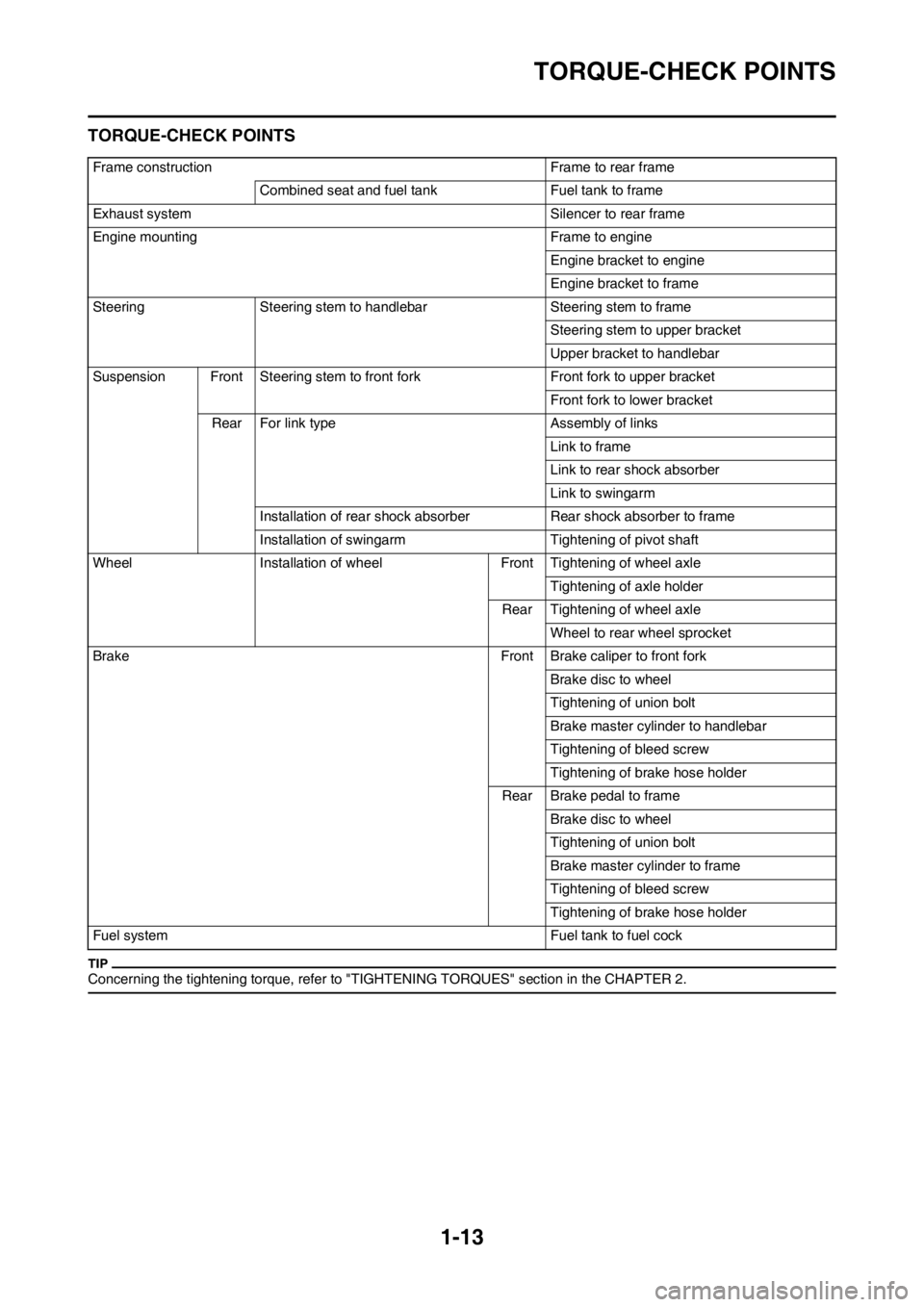
1-13
TORQUE-CHECK POINTS
TORQUE-CHECK POINTS
Concerning the tightening torque, refer to "TIGHTENING TORQUES" section in the CHAPTER 2.
Frame construction Frame to rear frame
Combined seat and fuel tank Fuel tank to frame
Exhaust system Silencer to rear frame
Engine mounting Frame to engine
Engine bracket to engine
Engine bracket to frame
Steering Steering stem to handlebar Steering stem to frame
Steering stem to upper bracket
Upper bracket to handlebar
Suspension Front Steering stem to front fork Front fork to upper bracket
Front fork to lower bracket
Rear For link type Assembly of links
Link to frame
Link to rear shock absorber
Link to swingarm
Installation of rear shock absorber Rear shock absorber to frame
Installation of swingarm Tightening of pivot shaft
Wheel Installation of wheel Front Tightening of wheel axle
Tightening of axle holder
Rear Tightening of wheel axle
Wheel to rear wheel sprocket
Brake Front Brake caliper to front fork
Brake disc to wheel
Tightening of union bolt
Brake master cylinder to handlebar
Tightening of bleed screw
Tightening of brake hose holder
Rear Brake pedal to frame
Brake disc to wheel
Tightening of union bolt
Brake master cylinder to frame
Tightening of bleed screw
Tightening of brake hose holder
Fuel system Fuel tank to fuel cock
Page 24 of 168
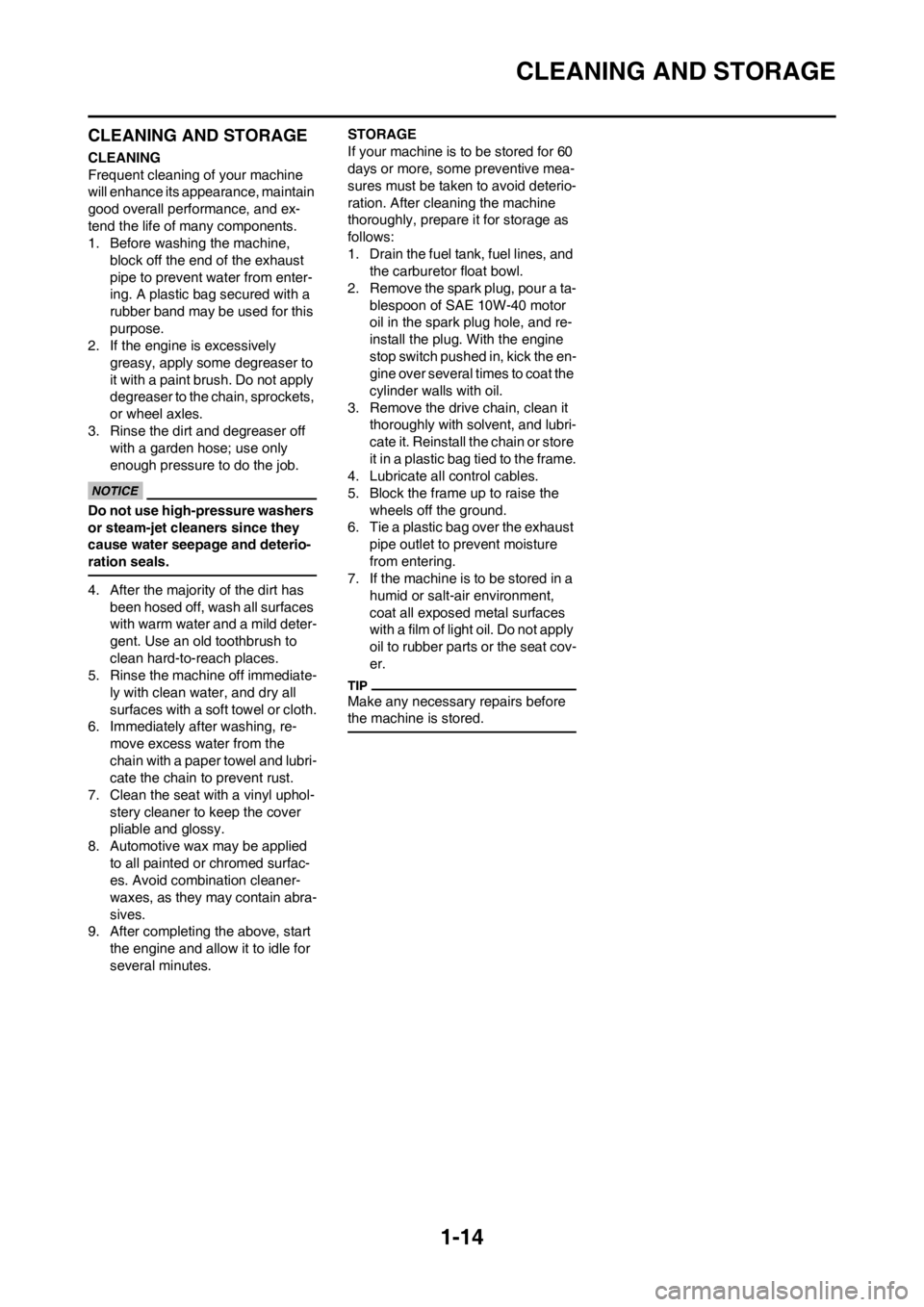
1-14
CLEANING AND STORAGE
CLEANING AND STORAGE
CLEANING
Frequent cleaning of your machine
will enhance its appearance, maintain
good overall performance, and ex-
tend the life of many components.
1. Before washing the machine,
block off the end of the exhaust
pipe to prevent water from enter-
ing. A plastic bag secured with a
rubber band may be used for this
purpose.
2. If the engine is excessively
greasy, apply some degreaser to
it with a paint brush. Do not apply
degreaser to the chain, sprockets,
or wheel axles.
3. Rinse the dirt and degreaser off
with a garden hose; use only
enough pressure to do the job.
Do not use high-pressure washers
or steam-jet cleaners since they
cause water seepage and deterio-
ration seals.
4. After the majority of the dirt has
been hosed off, wash all surfaces
with warm water and a mild deter-
gent. Use an old toothbrush to
clean hard-to-reach places.
5. Rinse the machine off immediate-
ly with clean water, and dry all
surfaces with a soft towel or cloth.
6. Immediately after washing, re-
move excess water from the
chain with a paper towel and lubri-
cate the chain to prevent rust.
7. Clean the seat with a vinyl uphol-
stery cleaner to keep the cover
pliable and glossy.
8. Automotive wax may be applied
to all painted or chromed surfac-
es. Avoid combination cleaner-
waxes, as they may contain abra-
sives.
9. After completing the above, start
the engine and allow it to idle for
several minutes.STORAGE
If your machine is to be stored for 60
days or more, some preventive mea-
sures must be taken to avoid deterio-
ration. After cleaning the machine
thoroughly, prepare it for storage as
follows:
1. Drain the fuel tank, fuel lines, and
the carburetor float bowl.
2. Remove the spark plug, pour a ta-
blespoon of SAE 10W-40 motor
oil in the spark plug hole, and re-
install the plug. With the engine
stop switch pushed in, kick the en-
gine over several times to coat the
cylinder walls with oil.
3. Remove the drive chain, clean it
thoroughly with solvent, and lubri-
cate it. Reinstall the chain or store
it in a plastic bag tied to the frame.
4. Lubricate all control cables.
5. Block the frame up to raise the
wheels off the ground.
6. Tie a plastic bag over the exhaust
pipe outlet to prevent moisture
from entering.
7. If the machine is to be stored in a
humid or salt-air environment,
coat all exposed metal surfaces
with a film of light oil. Do not apply
oil to rubber parts or the seat cov-
er.
Make any necessary repairs before
the machine is stored.
Page 25 of 168
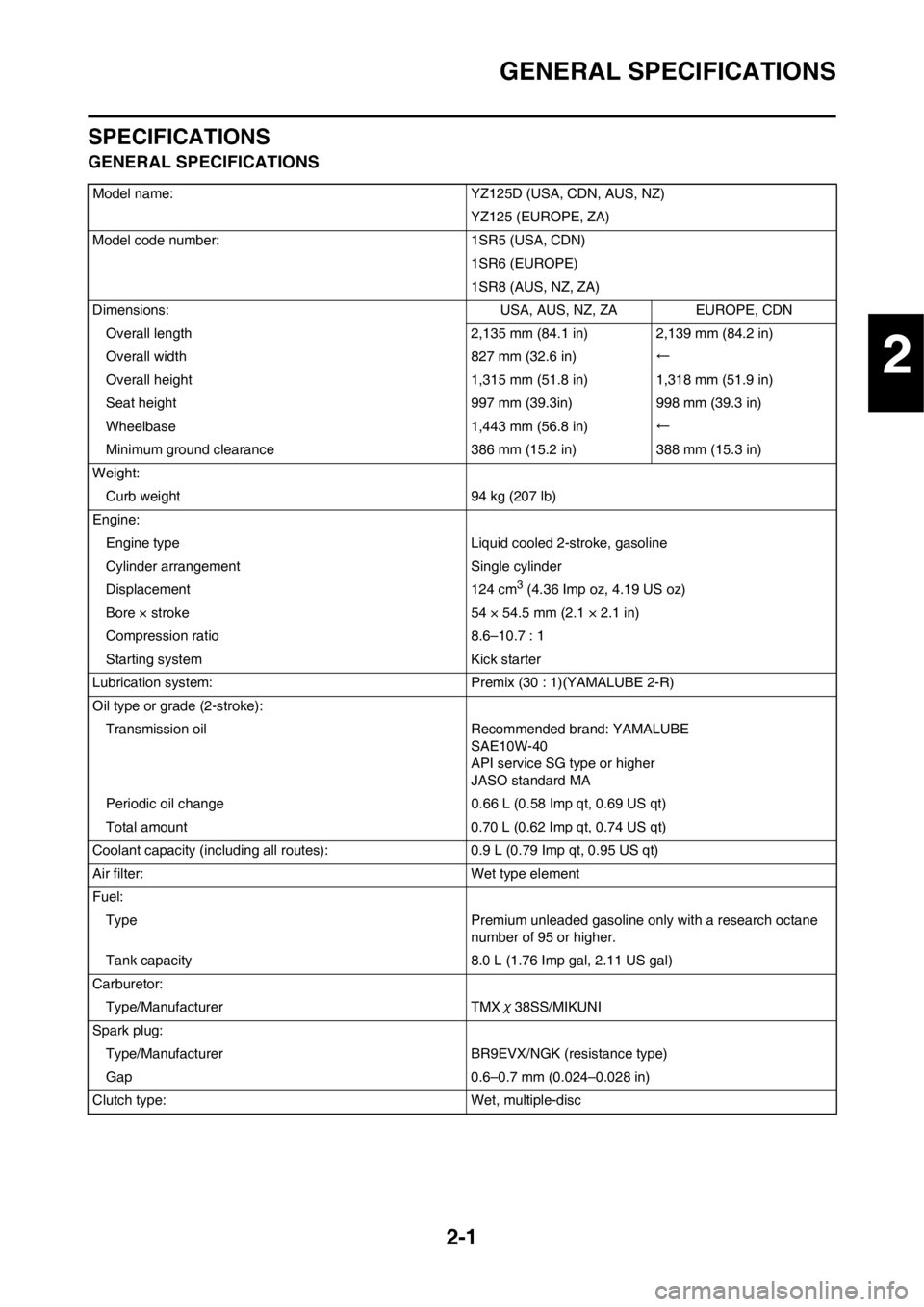
2-1
GENERAL SPECIFICATIONS
SPECIFICATIONS
GENERAL SPECIFICATIONS
Model name:YZ125D (USA, CDN, AUS, NZ)
YZ125 (EUROPE, ZA)
Model code number: 1SR5 (USA, CDN)
1SR6 (EUROPE)
1SR8 (AUS, NZ, ZA)
Dimensions: USA, AUS, NZ, ZAEUROPE, CDN
Overall length 2,135 mm (84.1 in) 2,139 mm (84.2 in)
Overall width 827 mm (32.6 in)←
Overall height 1,315 mm (51.8 in) 1,318 mm (51.9 in)
Seat height 997 mm (39.3in)998 mm (39.3 in)
Wheelbase 1,443 mm (56.8 in)←
Minimum ground clearance 386 mm (15.2 in)388 mm (15.3 in)
Weight: Curb weight 94 kg (207 lb)
Engine: Engine type Liquid cooled 2-stroke, gasoline
Cylinder arrangement Single cylinder
Displacement 124 cm
3 (4.36 Imp oz, 4.19 US oz)
Bore × stroke 54 × 54.5 mm (2.1 × 2.1 in)
Compression ratio 8.6–10.7 : 1
Starting system Kick starter
Lubrication system: Premix (30 : 1)(YAMALUBE 2-R)
Oil type or grade (2-stroke): Transmission oil Recommended brand: YAMALUBE SAE10W-40
API service SG type or higher
JASO standard MA
Periodic oil change 0.66 L (0.58 Imp qt, 0.69 US qt)
Total amount 0.70 L (0.62 Imp qt, 0.74 US qt)
Coolant capacity (including all routes): 0.9 L (0.79 Imp qt, 0.95 US qt)
Air filter: Wet type element
Fuel: Type Premium unleaded gasoline on ly with a research octane
number of 95 or higher.
Tank capacity 8.0 L (1.76 Imp gal, 2.11 US gal)
Carburetor: Type/Manufacturer TMX χ38SS/MIKUNI
Spark plug: Type/Manufacturer BR9EVX/NGK (resistance type)
Gap 0.6–0.7 mm (0.024–0.028 in)
Clutch type: Wet, multiple-disc
2
Page 26 of 168

2-2
MAINTENANCE SPECIFICATIONS
MAINTENANCE SPECIFICATIONS
ENGINETransmission:
Primary reduction system Gear
Primary reduction ratio 3.368 (64/19)
Final drive Chain
Secondary reduction ratio 3.692 (48/13)
Transmission type Constant mesh, 6-speed
Operation Left foot operation
Gear ratio:
1st 2.385 (31/13)
2nd 1.933 (29/15)
3rd 1.588 (27/17)
4th 1.353 (23/17)
5th 1.200 (24/20)
6th 1.095 (23/21)
Chassis: USA, AUS, ZA, NZ EUROPE, CDN
Frame type Semi double cradle←
Caster angle 25.50 ° 25.60 °
Trail 105 mm (4.1 in) 107 mm (4.2 in)
Tire:
Type With tube
Size (front) 80/100-21 51M
Size (rear) 100/90-19 57M
Tire pressure (front and rear) 100 kPa (1.0 kgf/cm
2, 15 psi)
Brake:
Front brake type Single disc brake
Operation Right hand operation
Rear brake type Single disc brake
Operation Right foot operation
Suspension:
Front suspension Telescopic fork
Rear suspension Swingarm (link type monocross suspension)
Shock absorber:
Front shock absorber Coil spring/oil damper
Rear shock absorber Coil spring/gas, oil damper
Wheel travel:
Front wheel travel 300 mm (11.8 in)
Rear wheel travel 315 mm (12.4 in)
Electrical:
Ignition system CDI magneto
Item Standard Limit
Cylinder head:
Combustion chamber volume 8.4 cm
3 (0.296 Imp oz, 0.284 US oz) ----
Warp limit ---- 0.03 mm
(0.0012 in)
Page 27 of 168
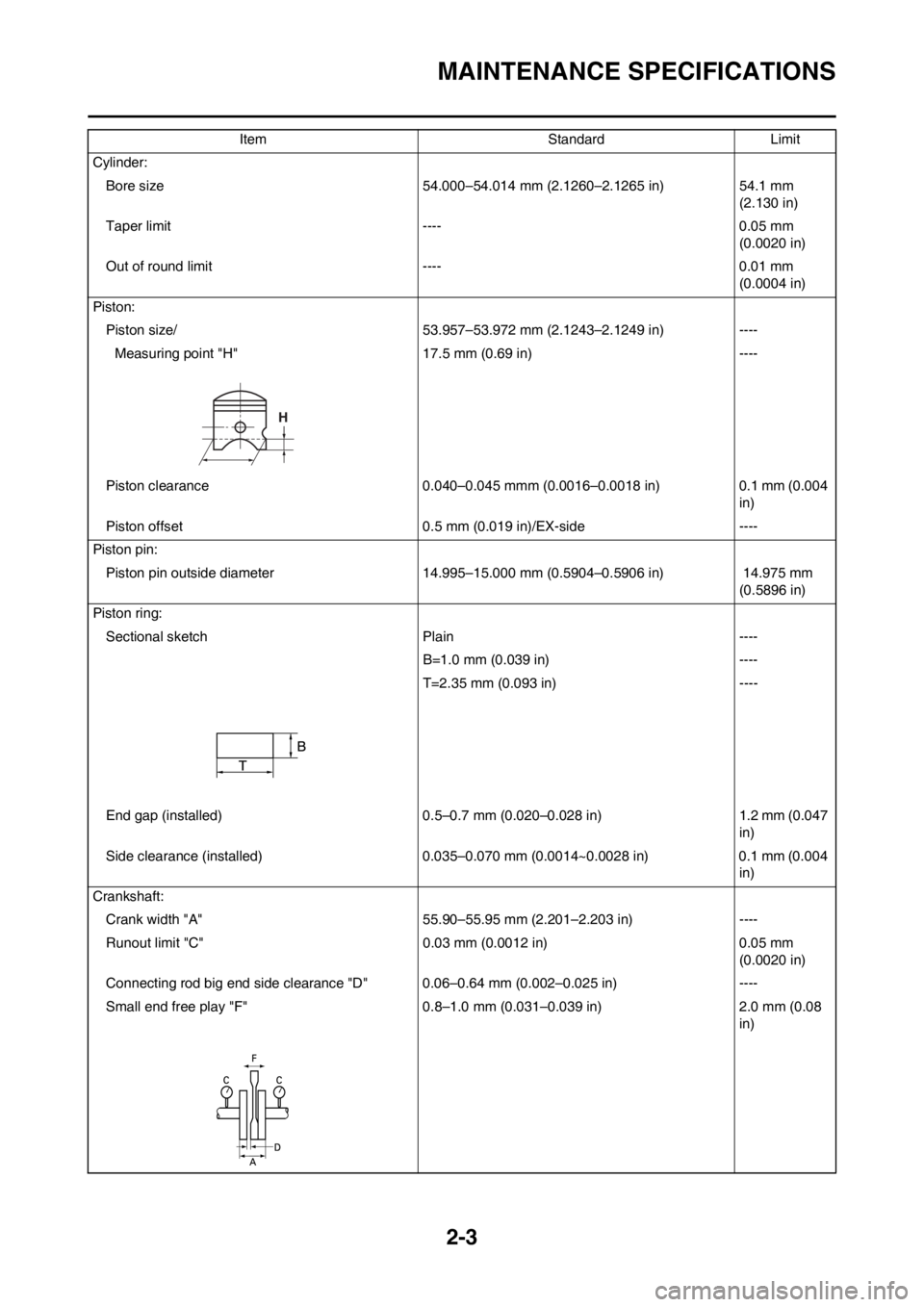
2-3
MAINTENANCE SPECIFICATIONS
Cylinder:
Bore size 54.000–54.014 mm (2.1260–2.1265 in) 54.1 mm
(2.130 in)
Taper limit ---- 0.05 mm
(0.0020 in)
Out of round limit ---- 0.01 mm
(0.0004 in)
Piston:
Piston size/ 53.957–53.972 mm (2.1243–2.1249 in) ----
Measuring point "H" 17.5 mm (0.69 in) ----
Piston clearance 0.040–0.045 mmm (0.0016–0.0018 in) 0.1 mm (0.004
in)
Piston offset 0.5 mm (0.019 in)/EX-side ----
Piston pin:
Piston pin outside diameter 14.995–15.000 mm (0.5904–0.5906 in) 14.975 mm
(0.5896 in)
Piston ring:
Sectional sketch Plain ----
B=1.0 mm (0.039 in) ----
T=2.35 mm (0.093 in) ----
End gap (installed) 0.5–0.7 mm (0.020–0.028 in) 1.2 mm (0.047
in)
Side clearance (installed) 0.035–0.070 mm (0.0014~0.0028 in) 0.1 mm (0.004
in)
Crankshaft:
Crank width "A" 55.90–55.95 mm (2.201–2.203 in) ----
Runout limit "C" 0.03 mm (0.0012 in) 0.05 mm
(0.0020 in)
Connecting rod big end side clearance "D" 0.06–0.64 mm (0.002–0.025 in) ----
Small end free play "F" 0.8–1.0 mm (0.031–0.039 in) 2.0 mm (0.08
in) Item Standard Limit
Page 28 of 168

2-4
MAINTENANCE SPECIFICATIONS
Clutch:
Friction plate thickness 2.9–3.1 mm (0.114–0.122 in) 2.8 mm (0.110
in)
Quantity 8 ----
Clutch plate thickness 1.5–1.7 mm (0.059–0.067 in) ----
Quantity 7 ----
Warp limit ---- 0.2 mm (0.008
in)
Clutch spring free length 40.1 mm (1.579 in) 38.1 mm
(1.500 in)
Quantity 5 ----
Clutch housing thrust clearance 0.15–0.26 mm (0.006–0.010 in) ----
Clutch housing radial clearance 0.01–0.04 mm (0.0006–0.0018 in) ----
Clutch release methodInner push, cam push ----
Transmission:
Main axle deflection limit ---- 0.01 mm
(0.0004 in)
Drive axle deflection limit ---- 0.01 mm
(0.0004 in)
Shifter:
Shifting type Cam drum and guide bar ----
Guide bar bending limit ---- 0.05 mm
(0.0020 in)
Kick starter type: Kick and mesh type ----
Kick clip friction force P=0.8–1.2 kg (1.8–2.6 lb) ----
Air filter oil grade (oiled filter): Foam-air-filter oil or equivalent oil ----
Carburetor: USA, CDN EUROPE AUS, NZ, ZA
Type/Manufacturer TMXχ38SS/
MIKUNI ←←
I.D. mark 1C37 51 1C36 41←----
Main jet (M.J.) #430←←----
Jet needle-clip position (J.N.) 6BFY43-74-3←←----
Cutaway (C.A.) 4.0←←----
Pilot jet (P.J.) #40 #45←----
Pilot air screw (P.A.S.) 2-1/4←←----
Valve seat size (V.S.) ø3.8 mm (0.15
in)←←----
Starter jet (G.S.) #80←←----
Fuel level (F.L.) 9.5–10.5 mm
(0.37–0.41 in)←←----
Reed valve:
Thickness 0.47 mm (0.019 in) ----
Valve stopper height 8.2–8.6 mm (0.323–0.339 in) ----
Valve bending limit ---- 0.2 mm (0.008
in) Item Standard Limit
Page 29 of 168

2-5
MAINTENANCE SPECIFICATIONS
CHASSISCooling:
Radiator core size:
Width 107.8 mm (4.24 in) ----
Height (left) 240 mm (9.45 in) ----
Height (right) 220 mm (8.66 in) ----
Thickness 32 mm (1.26 in) ----
Radiator cap opening pressure 95–125 kPa (0.95–1.25 kg/cm
2, 13.5–17.8 psi) ----
Radiator capacity (total) 0.56 L (0.49 Imp qt, 0.59 US qt) ----
Water pump:
Type Single-suction centrifugal pump ----
Item Standard Limit
Steering system:
Steering bearing typeTaper roller bearing ----
Front suspension: USA, CDN, ZA, AUS,
NZEUROPE
Front fork travel 300 mm (11.8 in)←----
Fork spring free length 454 mm (17.9 in)←449 mm (17.7
in)
Spring rate, STD K=4.1 N/mm (0.418
kg/mm, 23.4 lb/in)←----
Optional spring Yes←----
Oil capacity 524 cm
3 (18.4 Imp oz,
17.7 US oz) 526 cm3 (18.5 Imp oz,
17.8 US oz) ----
Oil grade Suspension oil "S1"←----
Inner tube outer diameter 48 mm (1.9 in)←----
Front fork top end 5 mm (0.2 in)←----
Rear suspension: USA, CDN, ZA, AUS,
NZEUROPE
Shock absorber travel 131.5 mm (5.18 in)←----
Spring free length Approx. 265 mm (10.43
in)←----
Fitting length*----
I.D. mark (Red/1) 258 mm (10.16 in) 252 mm (9.92 in) ----
I.D. mark (Red/2) 264 mm (10.39 in) 258 mm (10.16 in) ----
I.D. mark (Red/3) 255.5 mm (10.06 in) 249.5 mm (9.82 in) ----
Preload length
in)←----
Spring rate, STD K=46.0 N/mm (4.70
kg/mm, 263.2 lb/in)←----
Optional spring Yes←----
Enclosed gas pressure 1,000 kPa (10 kg/cm
2,
142 psi) ←----
* Spring specification varies according to the differ-
ence in the production lot.Item Standard Limit
Page 30 of 168

2-6
MAINTENANCE SPECIFICATIONS
Swingarm:
Swingarm free play limit
End ---- 1.0 mm (0.04
in)
Side clearance ---- 0.2–0.9 mm
(0.008–0.035
in)
Wheel:
Front wheel type Spoke wheel ----
Rear wheel typeSpoke wheel ----
Front rim size/material 21 × 1.60/Aluminum ----
Rear rim size/material 19 × 1.85/Aluminum ----
Rim runout limit:
Radial ---- 2.0 mm (0.08
in)
Lateral ---- 2.0 mm (0.08
in)
Drive chain:
Type/manufacturer DID520DMA2 SDH G&B/DAIDO ----
Number of links 111 links + joint ----
Chain slack 48–58 mm (1.9–2.3 in) ----
Chain length (15 links) ---- 242.9 mm
(9.563 in)
Front disc brake:
Disc outside dia.×Thickness 250 × 3.0 mm (9.84 × 0.12 in) 250 × 2.5 mm
(9.84 × 0.10 in)
Pad thickness 4.4 mm (0.17 in) 1.0 mm (0.04
in)
Master cylinder inside dia. 9.52 mm (0.375 in) ----
Caliper cylinder inside dia. 22.65 mm (0.892 in) × 2 ----
Brake fluid type DOT #4 ----
Rear disc brake:
Disc outside dia.×Thickness 245 × 4.0 mm (9.65 × 0.16 in) 245 × 3.5 mm
(9.65 × 0.14 in)
Deflection limit ---- 0.15 mm
(0.006 in)
Pad thickness 6.4 mm (0.25 in) 1.0 mm (0.04
in)
Master cylinder inside dia. 11.0 mm (0.433 in) ----
Caliper cylinder inside dia. 25.4 mm (1.000 in) × 1 ----
Brake fluid type DOT #4 ----
Brake lever and brake pedal:
Brake lever position 95 mm (3.74 in) ----
Brake pedal height (vertical height above footrest
top)0 mm (0 in) ----
Clutch lever free play (lever end) 8–13 mm (0.31–0.51 in) ----
Throttle grip free play3–5 mm (0.12–0.20 in) ---- Item Standard Limit